

BERGEN BEACH - Brooklyn, NY
1896 - 1918
Written by Jeffrey Stanton
Bergen Beach on the west shore of Jamaica Bay in today’s Brooklyn was initially inhabited by the Canarsie Indians. In the early 1600s the Dutch West India Company set up a trading post on nearby land, then called Mentelaer’s Island. The trading post brought money into the area, enlarging the settlement by mid-century. During the American Revolution, British officers used the island and the Bergen House as an outpost. Then in the 1850s, the land officially received the name Bergen Island after the descendants of Hans-Hansen Bergen, a Dutch settler in the 17th century.
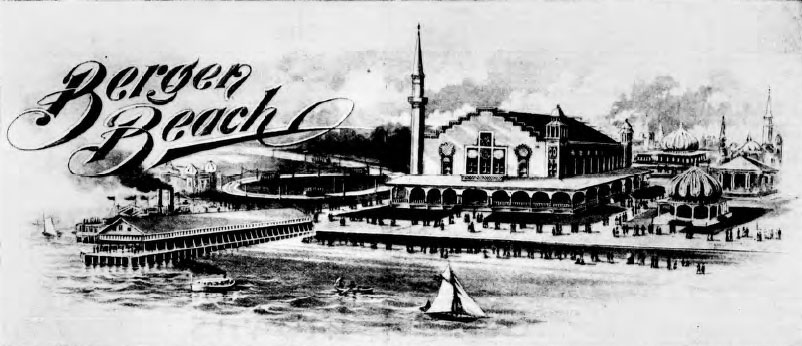
In the mid 1890s, developers chewing gum manufacturer (Chicklets) Percy Williams and Thomas Adams Jr. purchased part of the island, and.built a high class amusement park to rival Coney Island The resort and amusement park, accessible by the Flatbush Avenue streetcar and a short ferry ride. It opened in June 1896 as the Percy Williams Amusement Park, but soon just Bergen Beach..
Perhaps its best description is summarized from an August 9, 1896 New York Herald newspaper article. Coney Island lacks the refinements of gayety, compared to this brightly caparisoned and gilded resort within view of the cat-boat dotted waters of Jamaica Bay. From a distance as the trolley approaches it looks like a mass of orange and crimson boathouses.
All the gayety and frivolity is concentrated along the boardwalk which extends a half mile. The board walk echoes with the tread of Egyptian dancing girls, Irish villagers, knights in armor, girls in clinging lace costumes, young men in white duck trousers, soubrettes adorned with yellow tresses, jugglers, mountebanks, opera singers, and
Frankfurter sausage venders.
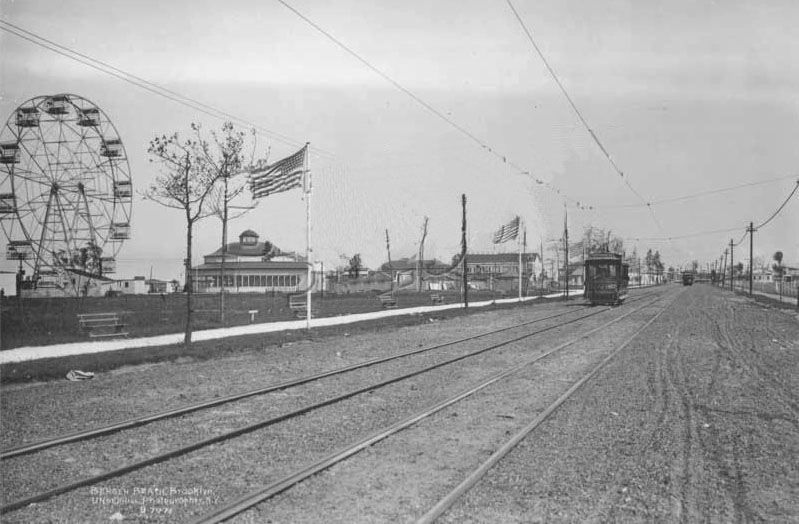
Approaching Bergen Beach along the trolley tracks.
The Casino is for dining either inside or on the veranda; steak or raw clams. Inside you can watch the soubrettes sing and dance.
There are annexes to the Casino on either end of the boardwalk where they sell drinks; hard and soft. The intervening gulfs (along the Boardwalk) are filled with Moorish castles, Egyptian encampments, Irish villages, black Americans, white Coney Island fakirs, blood testing machines, vitascopes, knock-the-baby-down skill games.
At the Irish Village the bally points to five song and dance men wearing corduroy breeches, green velvet waistcoats and red wigs, who he says came over for the World's Fair under the patronage of Her Grace, Lady Aberdeen. The will appear in their jigs, dances and native songs. Admission 10 cents.
Next door is the Mystic Moorish Maze which looks like a big dry goods box, plastered over and decked with turrets, minarets, towers and buttresses, in stucco. It is made up of doors without end. Once you get in you have difficulty getting out again. It is a maze of stuffy little rooms, and on a hot day, the airless interior causes one to sweat profusely and become aggravated as door after door one opens has a wall inscribed in classical Moorish,"Nit!" One comes to a door inscribed, "This is the door by which you came in." There is a pearl button for the purpose of summoning a guide. The panel flies back and shows in large letters the legend, "Souvenir if you get out alive."
Outside is an Egyptian encampment that is alive with dancing girls and camels. The fakir is talking. "Walk right up. Ladies as well as gentlemen admitted. Positively nothing here which would offend the most fastidious lady in the land. Refined, instructive and ennobling."
Then the band plays the coochee coochee, and the crowd pour into the dirty dusty enclosure.
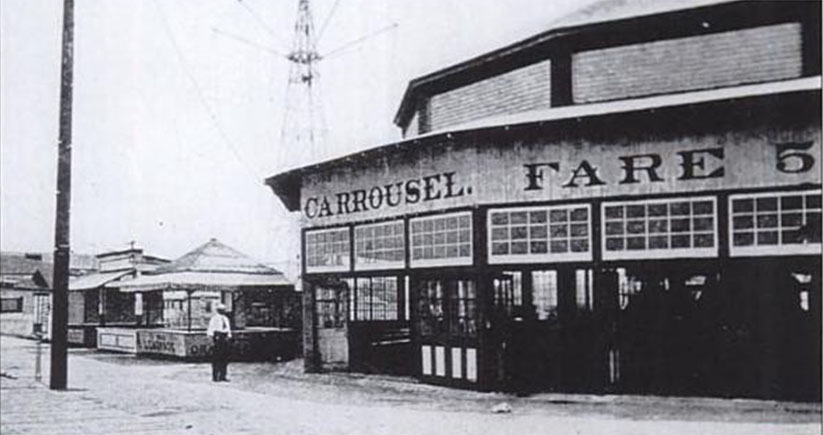
Carousel Building
There is opera, too among the attractions. The stage is a retired brick schooner, moored a few feet from the water's edge, in view of the bleachers erected on the beach. One can see remnants of a Gilbert and Sullivan production called "H. M. S. Pinafore," performed upon a real ship. You'll see Ralph Rackstraw, Josephine and Buttercup.
The L.A. Thompson scenic railway is called the Grand Colorado Cannon; perhaps it should have been spelled "Cannon". You get in a car and
are shot up and down inclined planes into a building with a black pitchy inside. At the entrance of the structure, as you wizz past, you see a green dragon with red eyes and a yellow tongue. He stands guard like Cerberus over the regions of the lost. You whizz on through inky blackness. A blinding light illuminates the cavern. You look over the side
of the reeling, whizzing car and see a painted mountain torrent dashing down paper mache rocks and a cactus of green billiard cloth waving morurnfully in the breeze. This is the great Colorado canon through which you are whizzing. The lights fade and you find yourself in a long and narrow passageway lined with pea green stalactites. It's a fairy grotto.
The Brooklyn Eagle newspaper added to the list of attractions. Rides included a 20-foot-high Ferris wheel, merry-go-round, and bicycle carousel. The Royal Automaton Theater, which featured puppet shows for children, was even more popular with adults, especially men that accompanied them. As the season progressed the percentage of children in the audience diminished. The vitascope, Edison's latest marvel, was one of the sights of the century. Moving life was perfectly simulated by means of full-sized figures projected on the screen. And for those who wanted to bathe in Jamaica Bay there was a large bathhouse for changing and renting of woolen bathing suits that nearly covered the entire body.
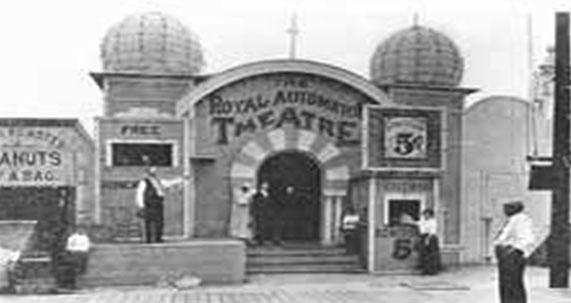
Royal Automaton Theater
There was also an Olympian arena where men clad in rusty armor and many anachronisms, break their lances for the favor of fair women and a glass of ale. And you can wander down to the quarters of "Black America" and listen to the melodies of the plantations by the way of Thompson Street. Mustang Charlie's Wild West Show featured real Indians (not white men mad up to resemble Indians). It featured exhibitions of rough riding and the perpetually bucking broncos. Paul Boyton’s water show was performed in an enclosure, but the show was so popular that park manager Ross managed to extend the show in early July by cancelling several of his other show dates.
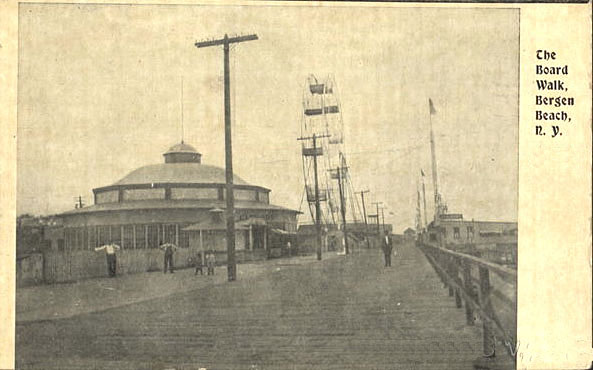
Along Bergen Beach's mile-long boardwalk
There were several improvements for the 1899 season according to newspapers. The Pneumatic chute, which likely ran through a tunnel was vastly improved, making the trip to the infernal regions more amusing than ever. In the Casino, the vaudeville show with "Natural Gas" with Eddie Girard as the principal comedian had been breaking receipt records. And the free aquatic show at the north end of the boardwalk drew enormous crowds.
In 1901, the newspapers reported the resort had a swimming pool and a touching illusion called" Little Jim" or the Collier's Dying Child. At the Casino Theater, a musical farce "The Pan-American Girl, was the first show at Bergen Beach to run over 100 nights. There was hippodrome with real Nags were not the usual horses used for pony tracks, but those horses from Western ranches had a gait that was a cross between a roller coaster and an earthquake.
There were reports as early as March 1902 that the resort wouldn’t open for the summer. The Brooklyn Rapid Transit Company, that ran trolleys to the resort, wanted to buy the amusement resort the previous summer, but wouldn't pay the asking price. They had offered about $500,000 for the beach, the Casino Theater, the Casino Pier, the Trocadero, the Alhambra dancing hall and the right to sublet all privileges. The beach company held out for $750,000 and then all negotiations fell through. With no deal, the railroad company retaliated by giving the resort poor trolley service Percy Williams continued to operate as usual although business suffered. People along both Flatbush and Nostrand Avenue lines, were compelled to wait many minutes to get to Bergen Beach. Although no one openly charged the railroad company with trying to kill business at
Bergen Beach, still this was the general rumor.
During the previous winter Bergen Beach was ripped from one end to the other by heavy waves driven by strong wind, which was rare for Jamaica Bay. Damage to the Boardwalk and structures was $100,000. Hardly any work had been done to repair that damage since Percy Williams asked the railroad to pay some of the costs of repair. Williams threat was that the transit company would lose considerable revenue if the resort didn't open. The railroad said that it would run the route to the beach regardless as it was the longest five cent ride in Brooklyn and the public would still ride it. They told Percy Williams that he would have to nail the planks himself. He fenced the resort off including the free beach so visitors couldn't see the resort.
When it was announced in January 1903 that the resort would reopen for the summer, the trolley company stated that it would open its new street car terminal near Bergen Beach. Trelley fares were only five cents. The Casino that summer debuted the the merry musical comedy, "The Girl in Black" which was so popular that it ran the entire summer. The Bombardment of Taku, likely a fireworks show, was performed in the free show enclosure on Monday, Wednesday and Friday evenings. Rosatl's Naval Reserve Band gave afternoon and evening concerts.
A fire nearly claimed the Bergen Beach resort on April 17, 1904 when flames erupted at 2:30 PM in the L.A. Thompson Scenic Railway building fronting the boardwalk. It started in a small room filled with paints and oils and likely due to spontaneous combustion. When the fire was discovered, Chief Day sounded the big alarm bell behind the Casino which could be heard across the meadows where some farmers were plowing their fields. The only source of water was in the bay and not much good as the tide was out. But the volunteers did manage to connect with enough water along the shore to pump a stream of water on the blaze. They managed to pump 27 gallons of water on the flames by the time the city fire fighters were approaching. The nearest fire station was three miles away and the next 4 miles away. The firemen arrived on the trolley cars with their engines towed behind. The engines couldn't get near enough to the water to employ suction lines as the tide was out. Then the tide began to come in. and in an hour the fire was controlled.
Besides the Thompson Building, where the blaze started, one hundred feet of the scenic railway, a show building, two small restaurant buildings, a pavilion and several small booths were destroyed. 300 feet of the boardwalk burned and 100 feet of the bulkhead.
Bergen Beach’s formal opening for the season was on June 18, 1904. “The People's Popular Price Pleasure Place” as the advertisements stated was for the people of modest means, who can't afford the prices as competing resorts. Its multitude of free attractions and the limit of 5 cents for the shows that charged pleased the working class. At the Casino, a free vaudeville show that was changed every week. "The Pier" employed a celebrated ladies band for orchestral concerts. And in the Palm Gardens, Quantino' Naval Reserve Band offered new programs every afternoon and evening. Newspaper advertisements mentioned a St Louis Fair electrical show, and the Automaton Theater with its miniature figures that appealed to children. To the north of the boardwalk was the Foolish House, the Ferris wheel. miniature railway, and many other places. To the south of the walk was the Scenic Railway, the Hall of Laughter, Palace of Illusions, Mount Pelee Eruption, the Alhambra Dining Pavilion, swimming pool and various attractions.
The weekend before the park’s formal 1907 season opening 14,000 people journeyed there, while its formal opening was on June 15th.
The biggest change for the 1907 season was the opening of a new skating rink. Roller skating became so popular that it was taking the place of dancing. It featured an excellent band that played afternoons and evenings, and competent instructors to teach beginners. The balconies that encircled the building allowed spectators to indulge in refreshments and watch the skaters below. Champion skaters competed for prizes every evening.
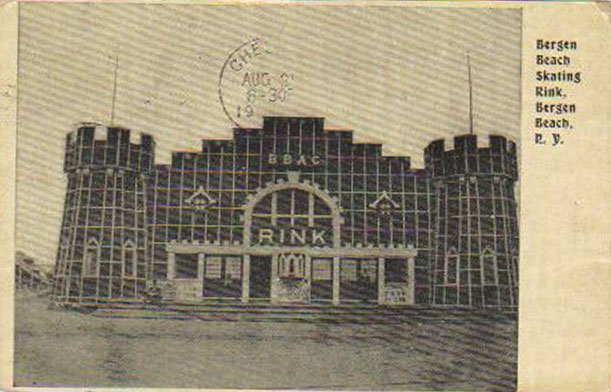
Bergen Beach Skating Rink
The Bergen Beach Company provided many free shows for the public. The most spectacular featured a daring diving act where a diver plunged from a height of 100 feet into the water below. Victor's Royal Venetian Band played free concerts both afternoons and evenings in the Palm Garden. The Casino on the pier offered vaudeville shows. The Hal Claterdon Stock Company changed their bill each week. Each show was a combination of singing, dancing and comedy acts. The Trocadero had an excellent animal show, and added a new lioness and leopard.
dancing acts, comedy acts, etc. The Alhambra ballroom popular with political and fraternal organizations who booked dates early in the winter. And the Automation Theater featured Uncle Tom's cabin with puppets.
Bergen Beach was badly damaged when fire swept through the resort on July 26, 1910. The fire started about 1 P.M. in the woods behind the park, then fanned by the wind, it soon spread through the buildings along the shore. The Automaton Theater, the Casino, the opera house, Steiner's Hotel and the Thompson Scenic Railway were enveloped by flames within 30 minutes. They were completely destroyed before firemen from Flatbush and Flatlands district arrived. As the wind was blowing away from the Carnarsie end of the resort, the Ferris wheel and other attractions at Bergen Beach were spared. Women and children, who made up the majority of the excursionists at the resort, made a safe escape. The loss was estimated at $400,000.
Despite having 20,000,000 newspaper pages from New York State online, it is difficult to discover when Bergen Beach was rebuilt and reopened. It does not appear in Billboard lists of amusement parks for the 1912 season. The only mention of the resort is in the November 18, 1911 NY Clipper where an agreement was reached between Percy G. Williams and Aeronautical Society of New York where they leased the premises for three years for the purpose of experimenting and constructing airplanes,
and organizing exhibitions of airplanes and hydro-aeroplanes, dirigibles and aeronautic apparatus of every nature. The land involved was 900 x 1080 feet with a water frontage of 1080 feet. They will were to be active from May to September.
However, it did open for the 1915 season as reported in both the Brooklyn Standard Union and Brooklyn Eagle newspapers. The resort, still owned by Percy G. Williams and Thomas A. Adams, opened on June 5th. It was completely renovated by 100 carpenters and other workers who were kept busy for a month by park manager William A. Masaud. It was reported that the dance hall and Casino were improved, and the roller rink was overhauled. There were several side shows for children, a new carousel, a motion picture theater, a scenic railway, a concert hall, and 1500 new row boats. Thousands of lamps suspended along its mile-long boardwalk made it a veritable fairyland of light in the evening.
The Brooklyn Eagle newspaper reported on May 30, 1919 that Bergen Beach was no longer an amusement resort, so it must have closed after the 1918 season. It just couldn’t compete with nearby Coney Island, and remained derelict for many years.
The Manhattan real estate developers Max Natanson and Mandlebaum & Levine purchased the resort area for two million dollars in 1925. They had planned to build a residential community featuring a bathing beach, pavilion and new amusement park. The plan never reached fruition, and the land was sold off piecemeal, remaining the largest undeveloped area in Brooklyn through the mid-1900s. The Bergen House itself was razed around 1930 to make way for the Belt Parkway. The remnants of the boardwalk and amusement park were torn down in 1939 when the Belt Parkway was actually constructed.